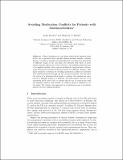Files in this item
Avoiding medication conflicts for patients with multimorbidities
Item metadata
| dc.contributor.author | Kovalov, Andrii | |
| dc.contributor.author | Bowles, Juliana Kuster Filipe | |
| dc.contributor.editor | Ábrahám, Erika | |
| dc.contributor.editor | Huisman, Marieke | |
| dc.date.accessioned | 2017-05-24T23:34:55Z | |
| dc.date.available | 2017-05-24T23:34:55Z | |
| dc.date.issued | 2016 | |
| dc.identifier | 241354487 | |
| dc.identifier | 70912c96-c4ef-4fdf-8d1e-15a01875ff02 | |
| dc.identifier | 84977518774 | |
| dc.identifier | 000379291800024 | |
| dc.identifier.citation | Kovalov , A & Bowles , J K F 2016 , Avoiding medication conflicts for patients with multimorbidities . in E Ábrahám & M Huisman (eds) , Integrated Formal Methods : 12th International Conference, IFM 2016, Reykjavik, Iceland, June 1-3, 2016, Proceedings . Lecture Notes in Computer Science , vol. 9681 , Springer , pp. 376-390 , 12th International Conference on integrated Formal Methods , Reykjavík , Iceland , 1/06/16 . https://doi.org/10.1007/978-3-319-33693-0_24 | en |
| dc.identifier.citation | conference | en |
| dc.identifier.isbn | 9783319336923 | |
| dc.identifier.isbn | 9783319336930 | |
| dc.identifier.issn | 0302-9743 | |
| dc.identifier.other | ORCID: /0000-0002-5918-9114/work/58055296 | |
| dc.identifier.uri | https://hdl.handle.net/10023/10849 | |
| dc.description.abstract | Clinical pathways are care plans which detail essential steps in the care of patients with a specific clinical problem, usually a chronic disease. A pathway includes recommendations of medications prescribed at different stages of the care plan. For patients with three or more chronic diseases (known asmultimorbidities) the multiple pathways have to be applied together. One common problem for such patients is the adverse interaction between medications given for different diseases. This paper proposes a solution for avoiding medication conflicts for patients with multimorbidities through the use of formal methods. We introduce the notion of a pharmaceutical graph to capture the medications associated to different stages of a pathway. We then explore the use of an optimising SMT solver (Z3) to quickly find the set of medications with the minimal number and severity of conflicts which is assumed to be the safest. We evaluate the approach on a well known case of an elderly patient with five multimorbidities. | |
| dc.format.extent | 15 | |
| dc.format.extent | 373318 | |
| dc.language.iso | eng | |
| dc.publisher | Springer | |
| dc.relation.ispartof | Integrated Formal Methods | en |
| dc.relation.ispartofseries | Lecture Notes in Computer Science | en |
| dc.subject | QA75 Electronic computers. Computer science | en |
| dc.subject | RM Therapeutics. Pharmacology | en |
| dc.subject | 3rd-DAS | en |
| dc.subject.lcc | QA75 | en |
| dc.subject.lcc | RM | en |
| dc.title | Avoiding medication conflicts for patients with multimorbidities | en |
| dc.type | Conference item | en |
| dc.contributor.sponsor | EPSRC | en |
| dc.contributor.institution | University of St Andrews. School of Computer Science | en |
| dc.identifier.doi | https://doi.org/10.1007/978-3-319-33693-0_24 | |
| dc.date.embargoedUntil | 2017-05-24 | |
| dc.identifier.url | http://www.springer.com/gb/book/9783319336923 | en |
| dc.identifier.grantnumber | EP/M014290/1 | en |
This item appears in the following Collection(s)
Items in the St Andrews Research Repository are protected by copyright, with all rights reserved, unless otherwise indicated.

